|
1910 |
January The Wright Company rents space from the Speedwell Motorcar plant
in Dayton, Ohio and begins to manufacture airplanes.
January 10 to 20 — The
Los Angeles Air Meet, the first
air meet in the United States, takes place at Dominguez Field.
January 17 The Wright Company hires
famous dirigible pilot A.
Roy Knabeshue to put together an exhibition flying team, the
"Wright-Fliers." Knabeshue begins to scour the country for
candidates.
Spring
Zeppelin airships, which
first flew in 1900, begin the first regularly scheduled air passenger
service. Between 1910 and 1914, this service carries over 35,000
passengers between German cities without a single mishap. Orville
Wright is one of those passengers.
March 2
Lt. Benjamin Foulois solos in Signal Corps No. 1
at Fort Sam Houston, after becoming the "only pilot ever to
learn to fly by correspondence" with Orville Wright.
For more than a year, Foulois is the US Army's only active
pilot and
Signal Corps No. 1
remains its only airplane.
March 8 — Baroness Raymonde de Laroche,
France, (her real name was Elise Deroche)
becomes
the first woman pilot to be granted a license to fly.
March 10
French pilot Emil Aubrun makes
the first night flights.
March 24
Orville Wright and Charlie
Taylor arrive in Montgomery, AL with five students and an airplane in
tow. They open a flight school at a location that will one day become Maxwell Air
Force Base. The Wright's first civilian students are Walter Brookins,
Arch Hoxsey, A. L. Welsh, Spencer Crane, and J. W. Davis.
Only Brookins, Hoxsey, and Welsh made it as pilots.
March 28
Henri Fabre makes the first
successful take-off from water in a seaplane that he designed and built.
Spring and Summer Lt.
Benjamin Foulois makes some important improvements to Signal
Corps No. 1, including adding seat belts and a wheeled
undercarriage.
April 27 to 28
Louis Paulhan, flying a Farman,
wins the first great air race, from London to Manchester in England. This
race impresses many, including Wilbur Wright, who predicts for the
first time in print that airplanes will one day cross the Atlantic Ocean.
May 10
Orville Wright leaves Walter
Brookins in charge of the flight school in Montgomery, Alabama and returns
to Dayton to train students at Huffman Prairie, now refurbished with a
larger hangar. Among his students are Frank Coffyn, Ralph
Johnstone, Phil O. Parmalee, J. Clifford Turpin, Howard Gill, and Leonard
Bonney. All of these men became pilots for the Wright-Fliers.
May 29
Glenn Curtiss flies 151
miles (243 kilometers) from Albany to New York City on the first cross-country flight in
America. He wins the New York World Prize of $10,000.
Summer
The Wright Brothers ask Arch
Hoxsey, a member of their exhibition team, to test a Wright Model
A that can be configured with the elevator in front, in back, or
both. Toward the end of the summer, Hoxsey is decided that the aircraft
flies best with the elevator in back. The Wrights also develop a wheeled
undercarriage, perhaps responding to reports from
Lt. Benjamin Foulois at Fort Sam
Houston.
June
— Lt. John W. Dunne, England, completes and tests the D.5,
the first successful powered flying wing and perhaps the first
inherently stable powered aircraft of any sort. Later this year he will
demonstrate the D.5 before an audience from the Royal Aero Club
that includes Orville Wright.
June 2
Charles S. Rolls, flying a
Wright
Model A, makes the first round-trip flight over the English
Channel and back again.
June 30
Glenn Curtiss makes the first
bombing runs from an airplane, dropping dummy bombs over Lake Keuka near
Hammondsport, NY.
July 10
Walter Brookins becomes the first pilot to fly over a
mile above the earth, achieving an altitude of 6234 feet
(1900 meters) in a Wright Model A over Atlantic City,
New Jersey.
August 20
Lt. Jacob Fickel fires a
Springfield rifle from an airplane piloted by Glenn Curtiss at a
target on the ground over Sheepshead Bay Speedway, Brooklyn, New York. He
scores one hit. This is the first time a gun is fired from an aircraft.
August 27
James McCurdy and Fredrick Baldwin, flying a
Curtiss biplane, receive and send telegraph messages on a Horton wireless set over Sheepshead Bay, New York.
It is the first time that a pilot in the air communicates with people on the
ground.
September 2
Blanche Stuart Scott
becomes the first American woman to solo an airplane. She was taught to
fly by Glenn Curtiss, although she never received a license.
September 23
Georges Chavez crosses the
Alps in a Bleriot monoplane, flying from Brig, Switzerland and
reaching a record altitude of 2200 meters (7,218 feet), but is fatally
injured in a crash landing at Domodossola, Italy.
October 3
Capt. Bertram Dickson,
England, flying a Farman biplane,
collides with Rene Thomas,
France in an Antoinette monoplane over Milan, Italy in the first mid-air
collision. Both pilots survive.
October 11
Former President Theodore Roosevelt goes aloft with
Arch Hoxsey at St. Louis, Missouri, becoming the
first US commander-in-chief to fly.
October 22 to 30
The Belmont International
Aviation Tournament, the first international air
meet in America gets underway at Belmont, NY. It offers a whopping $75,000
in prizes to draw aviators from all over the world. At this meet, the Wrights
unveil
what will become their most popular airplane, the Wright Model B. Like
their earlier craft, the Model B is a pusher biplane with wing-warping.
But is has a conventional tail and a wheeled undercarriage. They also bring a
special airplane the Wright Model R, dubbed the "Baby
Grand" to win the speed contest. During speed trials, it flies a
70 mph and is the favorite to win the race. But it crashes before the
competition begins.
October 25
Capt. Yoshitoshi Tokugawa, Japan, builds and
flies the first Japanese aircraft, the Kai-1. It's patterned
after a Farman design.
November 7
Phil Parmalee flies the
world's first air-freight shipment two bolts of silk cloth from Dayton to
Columbus, Ohio in a Wright Model B. The cloth is delivered to Morehouse-Martens
Department Store, where it is cut up into swatches and sold as souvenirs.
That same day Didier Masson flies a biplane designed by
E. Lilian Todd over Long Island, New York. Todd is first woman
aeronautical engineer.
November 14
Flying a Curtiss biplane, Eugene
Ely takes off from an 83-foot-long wooden deck built on the U.S.S.
Birmingham in Hampton, Roads, VA. This marks the birth of the
aircraft carrier.
November 17
Ralph Johnstone, a member
of the Wright exhibition team, fails to
pull out of a spiraling dive and dies in a crash. He is the
first American pilot to lose his life in an airplane.
|
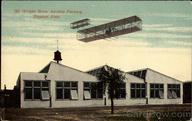
This postcard shows the Speedwell Motorcar building, the
first home of the Wright Company.
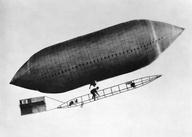
Roy Knabenshue flying his "Racing Airship" just before
signing on with the Wright brothers. He won a race with an
automobile in this dirigible.
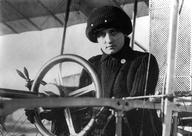
Baroness Raymonde de Laroche at the controls of her Voison.
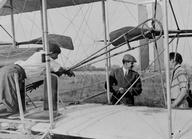
Orville talks with two of his students in Montgomery,
Alabama.
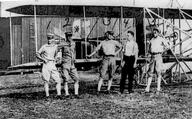
The Wright Military Flyer at Fort Sam Houston with its
flight crew. Note the wheels.
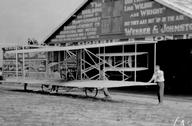
The hangar for the Wright Flying School near Montgomery,
Alabama was built by Montgomery businesses to the Wrights'
specs.
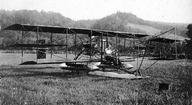
Curtiss' Albany Flyer was equipped with pontoons to serve as
flotation devices should Curtiss have trouble and have to
put down in the Hudson River.
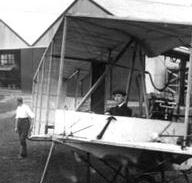
John William Dunne sits in the cockpit of the Dunne "D.5."
This was the first flying wing. The unusual design lifted
huge loads and was very stable in flight.
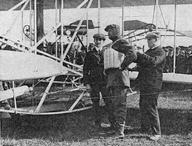
Charles Rolls dons a life preserver as he prepares to fly
roundtrip across the English Channel.
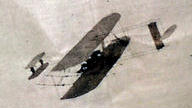
Walter Brookins climbs to an altitude of 6,1725 feet (1882
meters) over Atlantic City, setting a new altitude record.
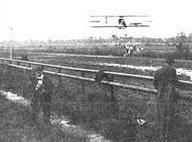
While flying at Sheepshead Bay, James McCurdy and Fredrick
Baldwin send and receive messages between and airplane and
the ground. Both men were pilots for
Glenn Curtiss.
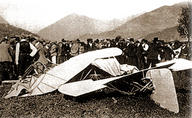
Chevas wrecked his Bleriot just 50 miles (80 kilometers)
short of his destination -- but he had crossed the Aps.
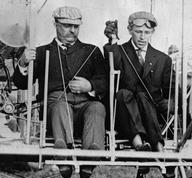
Arch Hoxsey instructs former President Theodore Roosevelt to
put his seat back and tray in the upright position.

The Wright Model R "Baby Grand" was powered by a V-8 engine,
the only eight-cylinder engine the Wrights ever built.
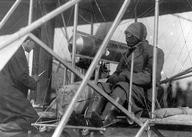
Phil Parmalee wrapped head to toe prepares to make the first
air freight flight.
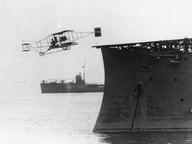
Eugene Ely takes off from a sloped wooden deck built on the
bow of the USS Birmingham.
|
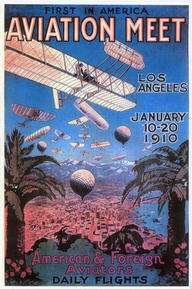
A poster announcing the 1910 Los Angeles Airmeet.
Forty-three aviators and budding young aviation companies
participated.
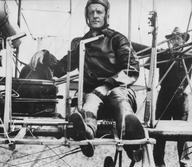
Lt. Benjamin Foulois in the cockpit of a Wright military
aircraft. In the seat beside him is a radio transmitter, a
telegraph key is attached to the elevator control stick.
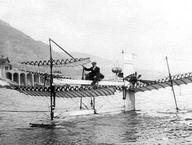
Henri Fabre taxis across the bay at Monaco in the first
successful seaplane, which he called a "hydravion."
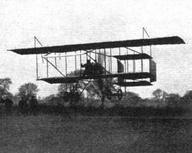
Louis Paulhan lands his Farman biplane in London after
flying 195 miles (314 kilometers) from Manchester in 12
hours with just one stop.

The new hangar for the flying school at Huffman Prairie was
very similar to the one in Montgomery, but it was not
covered by advertising.
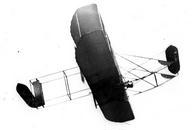
Arch Hoxsey flying outside of St. Louis; his Wright Flyer
configured to have two elevators one in front and the
other in back.
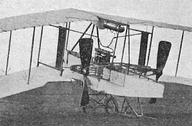
The D.5 from the rear. Dunne aircraft developed in
secret as the British believed the design had military
potential, perhaps a a stable bombing platform.
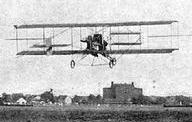
Glenn Curtiss drops dummy bombs (8-inch lengths of lead
pipe) on a mock warship made from paper. He hit his target
18 times out of 20.
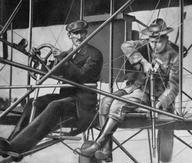
Lt. Fickel fires a rifle at a 3-foot by 5-foot paper target
from an altitude of 100 feet. He hit the target and later
repeated the feat with a semi-automatic pistol.
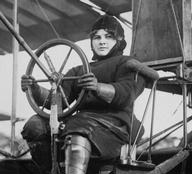
Blanche Stuart Scott in the cockpit of her Curtiss aircraft.
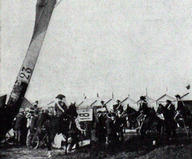
The aftermath of the first mid-air collision.
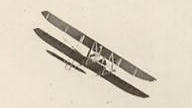
The Wright Model B, which was to become the Wright Company's
most popular aircraft, was unveiled at the Belmont
International Air Meet.
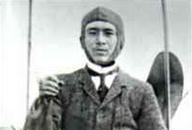
Capt. Yoshitoshi Tokugawa in the cockpit of his aircraft.
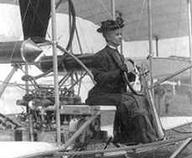
Lillian Todd in her biplane.
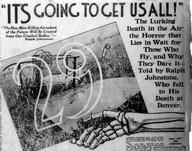
Sensational newspaper article about Johnstone's fatal
accident.
|